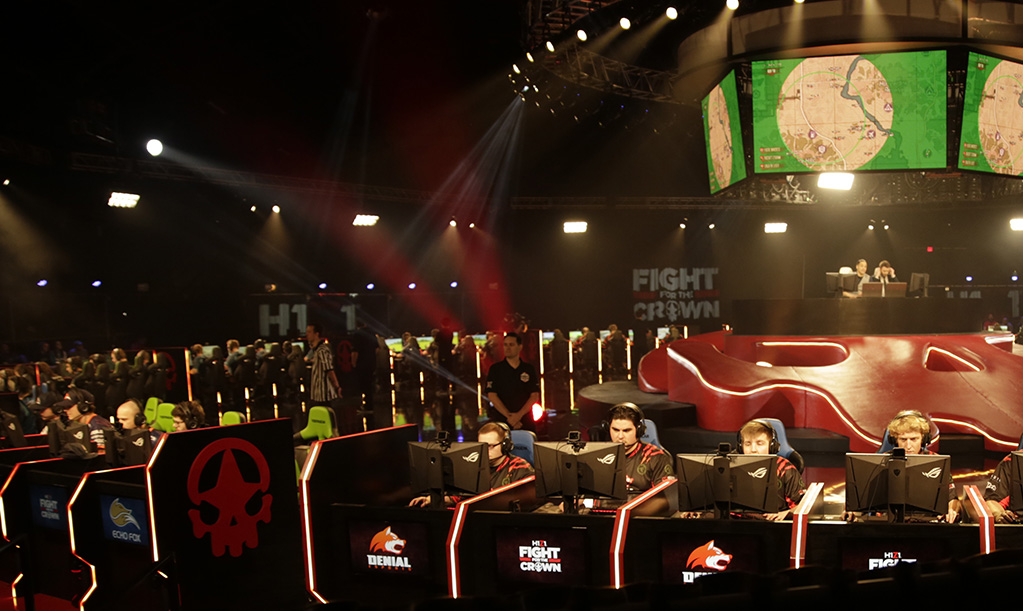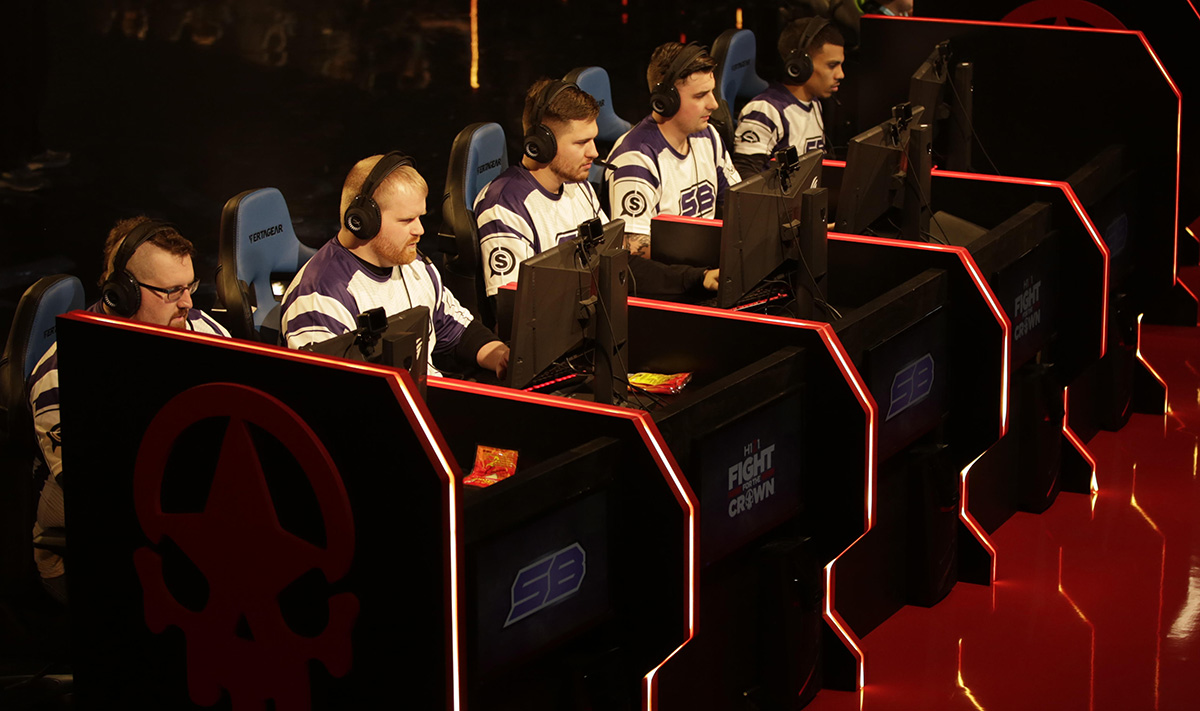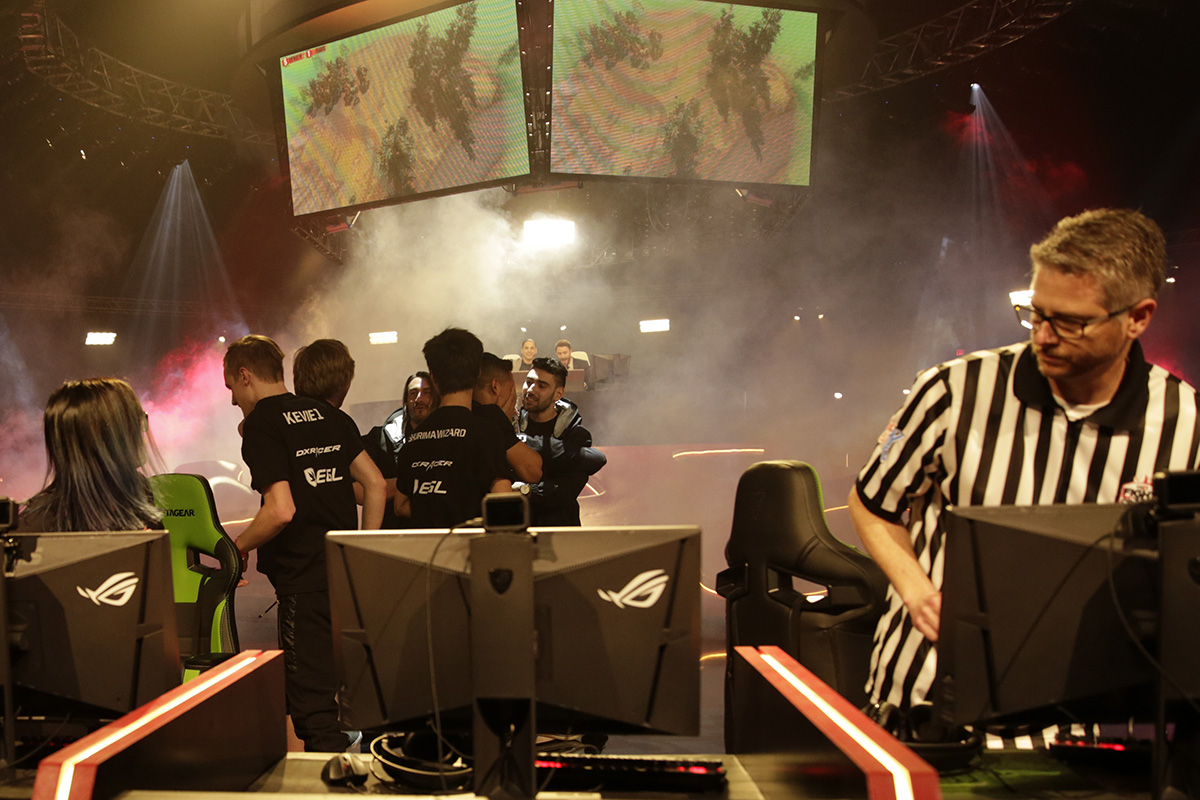Esports on TV: Behind the scenes of H1Z1's televised tournament
The infectious energy of a live event and the rehearsed spontaneity of an edited TV show make for an unusual mix.

The crowd of pro players is being told that they need to put white booties on over their shoes before walking onto the shiny black stage floor for rehearsal, and one player asks if his flip-flops count as shoes or if he should put the booties on over his bare feet. The fog machine is not producing fog, the players are also informed, but instead a "water-based haze" that shouldn't bother any allergies. As former NBA player Rick Fox stares at the screen of his phone while slowly pacing the circular stage—booties on—a production assistant strides over to another crew member, asking if there’s Red Bull anywhere on stage. "I have no idea," he's told. The PA hurries away. "I have no eyes on Red Bull," he reports gravely into his headset.
It's March, and I'm awkwardly trying to find a good place to stand in a crowded television studio—out of everyone's way but still close enough to observe everything—at the H1Z1: King of the Kill "Fight for the Crown" tournament in Los Angeles. With a $300,000 purse—$180,000 going to the winner, as well as smaller prizes for teams placing 2nd through 5th—it's the first official team-based tournament for Daybreak's Early Access battle royale shooter, and it will be edited and televised on the CW a month later. There are a lot of other firsts today: for some players it's their first tournament ever, and for many it's the first time they've met their teammates in person, despite playing with them online for months or even years. In the designated smoking area outside, I chat with a woman who has flown in from Wisconsin with one of the players, her nephew. "It's the first time he's been on a plane," she tells me.
Before the tournament begins, there are two practice matches scheduled. 15 teams of five players will parachute onto the map to begin looting buildings, scavenging weapons, ammo, armor, and first-aid. As they search for gear, a circle of poison gas will slowly close around the map, pushing the teams closer and closer to each other. The last team standing—even if only a single player on that team remains—wins.

75 Remain
So far, there's been a distinct lack of fighting and no killing to speak of.
The first practice match begins, and as the teams descend onto the map, the UI on the screen reads 75 REMAIN, 15 TEAMS. For the first few minutes, the teams are scattered widely over the map, scavenging in tight clusters and piling into vehicles together. But as the minutes pass and the circle of gas begins to close, teams draw near and conflict seems inevitable.
Still, for long minutes, there's not a single shot fired. Occasionally two teams will wind up just a few buildings apart in one of the map's towns. Their guns remain silent, however, and they eventually withdraw and head in different directions. More time passes. There's still no combat. It's not boring, but I do keep staring at 75 REMAIN, 15 TEAMS at the top of the screen. This is King of The Kill. This is Fight for the Crown. So far, there's been a distinct lack of fighting and no killing to speak of.
After the practice round, I spoke with Inboxes, a pro player for Rogue, the Las Vegas based esports organization, about the lack of action in the early minutes of the match, and if it was due to an abundance of caution or if the teams simply hadn't spotted each other.
"We saw a ton of people before anybody died," Inboxes told me. "We saw multiple cars, multiple teams, and I think just like every other team we made the conscious decision to get the hell out of there and stay alive as long as possible. Because that's what matters. Placement. It doesn't matter how many kills you get in these tournaments, it's placement."
Keep up to date with the most important stories and the best deals, as picked by the PC Gamer team.

In the end, it becomes a frantic and confusing bloodbath of hipshots and thrown grenades
Placement or not, by my watch it's now been more than twenty minutes of play and no one has even fired a single shot. 75 REMAIN, 15 TEAMS. I watch plenty of H1Z1 streams, as well as other battle royale games on Twitch, and I enjoy the building of tension between skirmishes. Right now, though, I'm beginning to wonder if this type of match will work for an edited television show. Despite the fact that the only activity thus far has been running, looting, and driving, the two announcers (Gold Glove and Ceez) have kept up the constant stream of patter and banter, but twenty solid minutes of players picking up guns and not firing them? It feels like it could be a struggle to present this in dramatic fashion on TV.
"We expected that," H1Z1's executive producer Chris Wynn tells me after the practice round ends. "I've been saying we'll go fifteen to twenty minutes without any action, and then you're gonna get a whole bunch. It's just the nature of what's at stake, and the fact that you get one chance so everyone's trying to be a little bit more cautious."
"That one went a little bit longer than I thought [it] would," Wynn admits. "And then you have just an explosion of action and it can be hard to follow."
Wynn is right: the first practice ends in sudden burst of violence that leaves the commentators and control room scrambling to capture what's actually happening and who it's happening to. With the circle of gas closed to perhaps a three city block radius, there are still 12 teams and 55 players remaining. In the end, it becomes a frantic and confusing bloodbath of hipshots and thrown grenades, enjoyable to watch but difficult to gauge the specifics of. Team Gates wins the practice round in what appears to be less of a strategic victory and more a sheer battle of reflexes.

One more time
Yeah, get pumped, and get out there... do it again.
Grimmybear
The teams leave the arena for a break, then walk back on for the second practice round. Once they've taken their seats on stage, they're told to get up and do it again: the producers want to see a bit more excitement from the players as they enter the arena. "More energy," is the directive. "Look for your people," meaning the audience cheering from the bleachers.
Since the tournament isn't being broadcast live, and the producers want to keep the results secret for a month until it airs, the audience for this event is comprised only of friends and family members the teams brought with them.
"Look for your people?" one player comments as the teams queue up to enter the arena properly for the third time. His team's bleacher section is nearly empty. "There's no one here for us."
"That was great," the stage manager announces after the players, more pumped and energetic this time, enter the arena and take their seats again. "One more time." The players get up again and shuffle back off. I begin to wonder if the starting, stopping, and waiting is taking a toll on players who are filled with Red Bull (provided some was found) and are no doubt just itching to play the game already. Does the pre-taped TV aspect of this tournament take a toll?
"Yeah, that's different," Grimmybear of Counter Logic Gaming tells me with a laugh when we talk during a break. Grimmybear has played in the H1Z1 Invitational tournaments, as well as tourneys for Counter-Strike and StarCraft: Brood War.
"It's not too bad, it's not really a problem," Grimmybear continues. "It's just, it's totally different than TwitchCon. You go there [at TwitchCon], they set up the computers, you get ready, and you just chill until the game starts and you're in. And this, they're like, ‘Yeah, get pumped, and get out there... do it again,’" he says, laughing. "So, it's different. But it's not bad. We know it's for TV."

We're people who play videogames in our rooms all day, you know. We're not actors, we're not used to doing multiple takes.
Inboxes
I ask Inboxes about the TV cameras and retakes as well. "Granted, all of us are... we're people who play videogames in our rooms all day, you know," he says. "We're not actors, we're not used to doing multiple takes.
"I mean obviously this is a little bit uncomfortable for some of us. We're not really used to it, but as for affecting the game itself, no, we're still going to be able to play in our element when the time comes."
As the players take their seats again, there's another wait as Jessica Chobot, host of the show, records a series of bumpers—the short video clips that will lead into commercial breaks during the edited broadcast.
"Things are quickly heating up, so don't go away, we'll be right back," Chobot says from her platform above the stage before the camera returns to position. In another take, she reads: "With over half the teams eliminated, we may have a winner here in just a few moments."
If the final tournament is anything like the first practice round, where 90% of the action is simply players gearing up followed by a quick mess of violence in the final few minutes, I have trouble imagining how they'll be able to use most of her lines.

Press reset
I have no idea who was killed.
Gold Glove
The second practice round eventually begins—and almost immediately ends. Shortly after the round starts, a player abruptly falls through the map and into videogame limbo, and the game has to be restarted. When I spoke to Chris Wynn at the 2017 Game Developers Conference, we discussed the possibility of an Early Access bug disrupting a tournament. This is just a practice round, but it's hard (for me, anyway) not to worry about something similar happening when the final match is in progress.
What's more, as the restarted match proceeds, I notice the 75 REMAIN indicator on the screen drop to 74 a few minutes in. There's no notification of a kill or a death, and no shots have yet been fired—the teams are nowhere near each other. As I watch, the 74 flips back to 75. A bit later, after a player has been eliminated, the screen reads 73 REMAIN. A few moments later, it jumps back to 74 again. Even here on the LAN, it appears a player has briefly lost their connection to the match a few times. Something else to worry about when the real tournament begins.
It's a livelier match this time: the teams are playing much more aggressively, engaging early, and taking risks. In part it's due to time constraints: the teams have been told the round will end in fifteen minutes, even if there's no winner by that time. So, the teams take chances, engage early, and it's a entertaining and eventful match from start to finish. With so much action, the commentators seem to have issues keeping up. "I have no idea who was killed," Goldy says after a violent skirmish. Luminosity Gaming, led by top-ranked H1Z1 player Ninja, wins the second practice round. Now all that's left is the real thing.
Showtime
The actual tournament, perhaps unsurprisingly, is a bit more like the first practice round than the second. Extreme caution reigns, and while eleven minutes into the match a few shots are fired, they don't result in any kills. It takes almost 20 minutes before the first player exits: it's Grimmybear, killed during a skirmish with Team Gates. As the circle closes, entire teams follow: Rebel, Cloud9, Echo Fox, Rogue, and CLG are all eliminated. The final three teams as the circle closes: Luminosity, World's Best Gaming, and Obey Alliance. Obey waits while the other two teams whittle each other down, then off the remainders without any of their own team dying to take home $180,000 of the $300,000 purse.
But did it make for good TV?

Watching the members of Echo Fox squat in a cloud of gas using bandage after bandage wasn't exactly gripping TV
I watched the tournament on the CW last night, and I really enjoyed it. Via the magic of editing, the show staggered the landings to show several teams getting their boots on the ground and give viewers some time to get a feel for the teams and where they were on the map. They also gave a good look at a couple of the battles, such as when the Ohio Rebels were wiped out, and highlighted some fun moments, like when CLG's plan to camp a rooftop fell apart after the wall of gas reached them before they had a chance to snipe another team, and they had to scamper to safety.
But there was a lot of padding in the hour-long special (such as showing the Ohio Rebels getting wiped out, again, after a commercial break). There were several long montages of player eliminations, though each elimination was shown so briefly it was hard to tell how or why most of the players were killed. And there were a number of cutaway segments of team members talking strategy (sort of), discussing what they planned to spend their winnings on (stuff), and which teams the players felt posed the biggest threat.
Not everything worked well on TV. Long distance firefights mostly looked like players hopping around and shooting at near-invisible specks on the screen. There were a lot of shots showing players driving in circles, and watching the members of Echo Fox squat in a cloud of gas using bandage after bandage wasn't exactly gripping TV, no matter how hard the announcers tried to make it so.
Perhaps H1Z1 isn't the perfect esport for television, but it was a good show: energetic, exciting at times and silly at others, and edited deftly enough that I didn't stare at the words 75 REMAIN for the first twenty minutes. Plus, nobody fell through the map or got disconnected. That's gotta count for a win.

Chris started playing PC games in the 1980s, started writing about them in the early 2000s, and (finally) started getting paid to write about them in the late 2000s. Following a few years as a regular freelancer, PC Gamer hired him in 2014, probably so he'd stop emailing them asking for more work. Chris has a love-hate relationship with survival games and an unhealthy fascination with the inner lives of NPCs. He's also a fan of offbeat simulation games, mods, and ignoring storylines in RPGs so he can make up his own.

